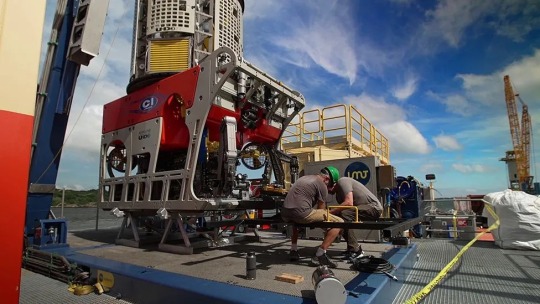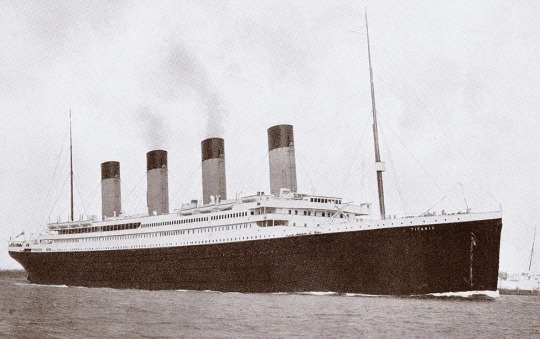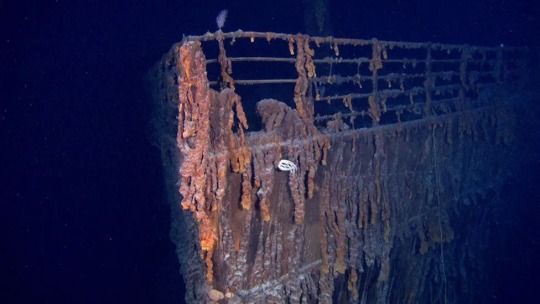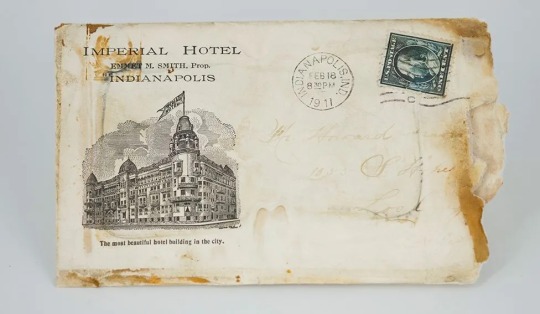#Paul-Henri “PH” Nargeolet
Explore tagged Tumblr posts
Text
Titanic Mission To Map Wreck In Greatest-Ever Detail
— By Jonathan Amos & Alison Francis | 12 July 2024

Six-tonne robots will spend up to 20 days mapping and cataloguing the wreck site
A team of imaging experts, scientists and historians set sail for the Titanic on Friday to gather the most detailed photographic record ever made of the wreck.
The BBC had exclusive access to expedition members in the US city of Providence, Rhode Island, as they made preparations to leave port.
They'll be using state of the art technology to scan every nook and cranny of the famous liner to gain new insights into its sinking.
This is the first commercial mission to Titanic since last year's OceanGate tragedy. Five men died while trying to visit the lost ship in a novel submersible.
A joint memorial service will be held at sea in the coming days for them and the 1,500 passengers and crew who went down with Titanic in 1912.
The new expedition is being mounted by the US company that has sole salvage rights and which to date has brought up some 5,500 objects from the wreck.
But this latest visit is purely a reconnaissance mission, says RMS Titanic Inc, based in Atlanta, Georgia.
Two robotic vehicles will dive to the ocean bottom to capture millions of high-resolution photographs and to make a 3D model of all the debris.
"We want to see the wreck with a clarity and precision that's never before been achieved," explained co-expedition lead David Gallo.

Titanic was the largest and most luxurious passenger ship of its day
The logistics ship Dino Chouest is going to be the base for operations out in the North Atlantic.
Weather permitting, it should spend 20 days above the wreck, which lies in 3,800m (12,500ft) of water.
It will be a poignant few weeks for all involved.
One of the five who died on the OceanGate sub was Frenchman Paul-Henri ("PH") Nargeolet. He was the director of research at RMS Titanic Inc and was due to lead this expedition.
A plaque will be laid on the seabed in his honour.
"It's tough but the thing about exploration is that there's an urge and a drive to keep going. And we're doing that because of that passion PH had for continuous exploration," explained friend and historian Rory Golden, who will be "chief morale officer" on Dino Chouest.

On its last visit in 2010, RMS Titanic Inc made a sonar map of the wreck site
There can be few people on Earth who don't know the story of the supposedly unsinkable Titanic and how it was holed by an iceberg, east of Canada, on the night of 15 April 1912.
There are countless books, movies and documentaries about the event.
But although the wreck site has been the target of repeated study since its discovery in 1985, there still isn't what could be described as a definitive map.
And while the bow and stern sections of the broken ship are reasonably well understood, there are extensive areas of the surrounding debris field that have received only cursory inspection.

There is still much to learn about Titanic, even its famous bow
Two six-tonne remotely operated vehicles (ROVs) intend to put that right. One will be fitted with an array of ultra-high-definition optical cameras and a special lighting system; the other will carry a sensor package that includes a lidar (laser) scanner.
Together, they'll track back and forth across a 1.3km-by-0.97km section of seafloor.
Evan Kovacs, who's in charge of the imaging programme, says his camera systems should produce millimetre resolution.
"If all of the weather gods, the computer gods, the ROV gods, the camera gods - if all those gods align, we should be able to capture Titanic and the wreck site in as close to digital perfection as you can get. You would be able to quite literally count grains of sand," he told BBC News.

Powerful cameras should return unprecedented detail from the deep
There's huge anticipation for what the magnetometer aboard the sensor ROV might produce. This is a first for Titanic.
The instrument will detect all the metals at the wreck site, even material that is buried out of sight in the sediment.

The sensor instruments, including the magnetometer, will return fascinating new data
"It would be an absolute dream to determine what has happened with Titanic's bow below the seafloor," explained geophysics engineer Alison Proctor.
"Hopefully, we'll be able to deduce whether or not the bow was crushed when it hit the seabed, or if it might actually extend down well into the sediment intact."
The team wants to review the state of some well known objects in the debris field, such as the boilers that spilled out as the opulent steamliner broke in half.

A rendering of what the electric candelabra might have looked like
There's the desire, too, to locate items thought to have been sighted on previous visits. These include an electric candelabra, which in its day would have been a fascinating curio, as well as the possibility of a second Steinway grand piano.
The musical instrument's wooden surround would have long since decayed away, but the cast iron plate, or frame, that held the strings should still be there, and perhaps even some of the keys.
"For me, it's the passengers' possessions, especially their bags, that are of greatest interest," said Tomasina Ray, who curates the collection of Titanic artefacts held by the company.
"It's their belongings - if we are able to retrieve more in the future - that help flesh out their stories. For so many passengers, they are just names on a list, and it's a way to keep them meaningful."

Rory Golden says the memorial plaque for PH will be placed upright in the sediment
This will be RMS Titanic Inc's ninth visit to the wreck site. The firm has attracted controversy in recent years with its stated desire to try to bring up part of the Marconi radio equipment that transmitted the distress calls on the night of the sinking.
It won't happen on this expedition but if and when it does occur, it would mean extracting an object from inside the disintegrating ship.
For many, Titanic is the gravesite to the 1,500 who died that night in 1912 and should not be touched, its interior especially.
"We get that and understand it," said company researcher James Penca.
"We dive to Titanic to learn as much as we can from her; and like you should with any archaeological site, we do it with the utmost respect. But to leave her alone, to just let her passengers and crew be lost to history - that would be the biggest tragedy of all."

It is the personal items, some preserved inside bags, that tell the stories of the dead

James Penca has the famous ship's radio call sign - "MGY" in morse code - tattooed on his arm
— Additional Reporting By Rebecca Morelle and Kevin Church
#Science & Environment#Shipwrecks#Photography#RMS Titanic#Atlantic Ocean 🌊#Titanic Mission#Map Wreck#Greatest-Ever Detail
2 notes
·
View notes
Text
What's known so far about the search for the missing Titanic submersible
The submersible last headed for the Titanic off the coast of Newfoundland is still missing as of Tuesday morning.
The U.S. Coast Guard is leading the operation with assistance from the Canadian Coast Guard vessel Kopit Hopson 1752 and air search from the Royal Canadian Air Force Aurora aircraft out of 14 Wing Greenwood.
5 Things to Know newsletter: Sign up to start your day with the biggest stories
Sign up for breaking news alerts from CTV News
The passenger submersible operated by OceanGate left St. John's, N.L. on Sunday morning and then lost contact with surface crews one hour and 45 minutes into the expedition.
Time is of the essence in the search due to the 96-hour oxygen supply aboard the vessel.
Here's what we know so far about the missing submersible:
WHO IS ON BOARD?
The submersible is carrying five passengers, including Hamish Harding, a billionaire and explorer, Paul-Henry (PH) Nargeolet, a French explorer, Shahzada Dawood and his son Suleman, members of one of Pakistan's prominent families and, according to Reuters, OceanGate CEO Stockton Rush.
"We started steaming from St. Johns, Newfoundland, Canada yesterday and are planning to start dive operations around 4am tomorrow morning," Harding wrote on Facebook on Saturday. "The team on the sub has a couple of legendary explorers, some of which have done over 30 dives to the RMS Titanic since the 1980s including PH Nargeolet."
WHAT THE SEARCH LOOKS LIKE
Former U.S. Coast Guard captain Andrew Norris told CTV's Your Morning on Tuesday "time really is the enemy."
"The challenge is finding it… that's going to be difficult enough, but then affecting some sort of rescue," he said. "That indicates the challenge that rescuers will face to do some sort of recovery, even if they do find it."
Search and rescue teams are battling the clock as the oxygen onboard the submersible lasts about 96 hours. Norris indicated there could be emergency oxygen supplies on board as well.
"They would have the normal oxygen supply that we're talking about that is a 96-hour window, but they'd also have — like on a plane if there was a fire or something — they'd have the ability to put on some sort of oxygen breathing device," Norris said.
The U.S. Coast Guard said at a press conference Monday that sonar technology is playing a key role in the search efforts.
If the vessel is found, Norris says, the rescue would be in "very difficult circumstances."
"The Sea State has to allow the deployment of that equipment, they have to and then it has to work kind of perfectly the first time so it's really a challenge," he said.
Beth Penney, a reporter with CTV News affiliate NTV in Newfoundland, told CTV's Your Morning on Tuesday that weather conditions have not been good for search efforts.
"We learned through social media, that this was going to be the only expedition that OceanGate was going to take to the Titanic wreckage this year, and that's because of poor weather conditions in Newfoundland and Labrador," Penney said.
CANADA'S ROLE IN THE SEARCH
The area where the submersible went missing is under U.S. jurisdiction, Minister of Fisheries, Oceans and the Canadian Coast Guard, Joyce Murray, told CTV News.
"There is a unified command under the U.S. Coast Guard’s leadership that Canada is playing a very committed role in," she said. "The Canadian Coast Guard is doing everything that we can to help. We have the CCGS John Cabot (that) has sonar and it is headed to the site."
Both the U.S. and Canadian coast guards have teams looking for the submersible and the Royal Canadian Air Force has an aircraft flying above.
"Maritime Rescue Coordination Centre (MRCC) Boston has requested assistance from Joint Rescue Coordination Centre (JRCC) Halifax in the search of an overdue submarine," a spokesperson from the RCAF told CTVNews.ca in an email. "The submersible has lost communications with its surface vessel located 380NM south of St. John’s N.L."
Kathryn Hallett, a spokesperson from Fisheries and Oceans Canada told CTVNews.ca in an email, "Joint Rescue Coordination Centre (JRCC) Halifax is providing assistance as required."
Murray says two other Canadian Coast Guard ships are in St. John's ready to port equipment.
When asked if any Canadian facilities came in contact with the submersible Murray initially said she would not "go into details."
"Because this is a hugely emotional issue for those who are doing this work to save the people aboard the submersible and their families, and every effort is being made," she said. "It's an international initiative at this point with assets coming from Great Britain and Germany."
However, Murray confirmed that Canadian facilities are doing "everything in their power" to assist in the search.
WHY IT COULD HAVE LOST CONTACT
Norris says there are multiple ways for a submersible to lose contact with the surface crew.
"There could have been a catastrophic breach, which would have resulted in an implosion, it could have had some sort of fault that caused it to lose communications and or the ability to lift itself off the seabed," Norris speculated.
Other potential issues include getting caught in debris that can be found along the ocean floor and near the Titanic.
Officials have not confirmed why the submersible lost contact.
WHERE WERE THEY GOING?
OceanGate Inc. is a privately owned U.S.-based company that provides tourism explorations to the deep ocean.
The company's website says the five-person submersible, named Titan, can reach depths of up to 4,000 metres — 7.2 times as tall as the CN Tower.
The Titanic, which sank in 1912, is located about 600 kilometres southeast of Newfoundland in the North Atlantic Ocean. OceanGate expeditions to the wreck cost passengers about C$300,000.
The submersible is made of carbon fibre and titanium and is 6.7 metres long.
from CTV News - Atlantic https://ift.tt/3VW1CqX
1 note
·
View note
Text
I just watched a 60 minutes interview with James Cameron about this and there’s a clip of Stockton piloting his toy sub with visible condensation inside the window. He’s in his socks with a game controller going around in circles in the dark at depths unimaginably deep. He had no idea what literal pressure he was under and that literal pressure literally killed him.

I have a theory that the expert who Stockton hired, Paul-Henri Nargeolet, knew exactly how bad it was. PH had a personal death wish after the death of his wife and wanted to rest his body at the wreckage site because…well. people who get obsessive over titanic probably get it. It’s so incredibly dark down at the bottom of the sea floor and if you don’t know where you are going and what direction the ocean currents are you can easily get caught in the iron cables that held the smokestacks to the deck. It’s insanely dangerous for so many factors other than there’s a lot of water. Basically the entire thing was a shit show from the start and the only reason it continued and concluded the way it did is because of money.
Capitalism. Full stop.
i read the recent wired article about the ocean gate titanic sub and i think the most understatedly eyebrow raising aspect of that whole debacle honestly is that the ceo seems to have been personally manning half their unsafe deep sea dives... like usually in a story like this it turns out the people at the top were brushing off safety concerns because they knew they personally could avoid consequences and were willing to risk their employees and customers. and im sure there were some people at ocean gate doing that. but stockton rush was as far as i can tell genuinely convinced of his own genius corner cutting engineering hacks to the point where he kept manning these vessels even after tests where they were failing and warnings from university labs and boeing engineers and hearing the hull make ominous creaking sounds while he himself was piloting it like... man with zero survival instincts to a point seldom seen in wealthy startup assholes who absolutely have the financial wherewithal to save their own necks
#the only people allowed to go near my gf (the wreck of the titanic) are fellow obsessive nerds who RESPECT. HER. AND. PHYSICS#leave her aloneeeeeee she’s just sitting pretty doing her thing let the scientists watch and document her rot away#rms titanic#oceangate
5K notes
·
View notes
Text
Thursday a 'critical day' as crews continue search for missing Titanic submersible
Crews searching for a missing submersible headed for the Titanic offered no updates overnight into Thursday morning as the timeline for the remaining oxygen on board ticked down.
Wednesday began early with reports of undersea noise detected in the search are, though that yielded no further leads on the location of the missing vessel.
Sign up for breaking news alerts from CTV News
But Thursday marked the day the estimated oxygen supply on board is likely to reaching its maximum 96-hour mark.
The U.S. Coast Guard, which is leading the effort, did not provide updates on the search for the submersible, called the Titan, which went missing off the coast of St. John's early Sunday morning during a dive to the wreck of the Titanic.
The Associated Press reported the air supply is expected to end between 6 a.m. and 8 a.m. EDT today, based on the information given by the U.S. Coast Guard and OceanGate Expeditions, the submersible's owner and operator.
The Titan is carrying five passengers: Hamish Harding, a billionaire and explorer; Paul-Henry (PH) Nargeolet, a French explorer; Shahzada Dawood and his son, Suleman, members of a prominent Pakistani family; and OceanGate CEO and Titan pilot Stockton Rush.
'A CRITICAL DAY'
On Thursday, co-founder of OceanGate Guillermo Sohnlein wrote on Facebook, "today will be a critical day."
"I'm certain that Stockton (Rush) and the rest of the crew realized days ago that the best thing they can do to ensure their rescue is to extend the limits of those (oxygen) supplies by relaxing as much as possible," Sohnlein said. "I firmly believe that the time window available for their rescue is longer than what most people think."
Officials said Wednesday that efforts to find the submersible would scale up hour-by-hour overnight into Thursday morning.
The submersible was headed to the site of the 1912 sinking of the Titanic, located approximately 600 kilometres off the coast of Newfoundland at a depth of about 3,800 metres.
The crew aboard the support ship, the Polar Prince, lost contact with the submersible on Sunday an hour and 45 minutes into its dive.
OceanGate Expeditions, has been running tours to the British ocean-liner since 2021. Since the disappearance, details have emerged from a 2018 engineering report alleging issues with the submersible's structure.
On Tuesday, a Canadian aircraft picked up "underwater noises" from one area of the search. Officials quickly supplied the area with teams in hopes of finding the location of the submersible.
from CTV News - Atlantic https://ift.tt/km4pZwA
0 notes
Text
Canadian plane detects sounds in search for missing submersible
A Royal Canadian Air Force (RCAF) plane involved in a search for a missing submersible headed for the Titanic has detected "underwater noises".
Just after midnight EDT on Wednesday, the U.S. Coast Guard said on Twitter, both underwater and air searches were "relocated in an attempt to explore the origin of the noises."
It's not clear whether the sounds are linked to the missing submersible.
Sign up for breaking news alerts from CTV News
Search crews are looking for a submersible carrying five passengers that lost contact with its surface ship the Polar Prince early Sunday morning after leaving St. John's, N.L.
The missing vessel is named the Titan and was heading to the 1912 wreckage of the Titanic, which is located about 600 kilometres off the coast of N.L. The tours are owned and operated by OceanGate, a U.S.-based company.
The submersible is carrying Hamish Harding, a billionaire and explorer, Paul-Henry (PH) Nargeolet, a French explorer, Shahzada Dawood and his son Suleman, members of a prominent Pakistani family, and OceanGate CEO and Titan pilot Stockton Rush.
The U.S. and Canadian coast guards and RCAF have crews looking for the vessel that lost contact an hour and 45 minutes into the expedition.
Officials said Tuesday afternoon at 1 p.m. EDT there was enough oxygen remaining on board the Titan for only 40 hours.
"This is a complex search effort which requires multiple agencies with subject matter expertise and specialized equipment," Capt. Jamie Frederick of the U.S. Coast Guard told reporters during a press conference in Boston on Tuesday.
The sounds discovered by a Canadian aircraft are the first potential lead in the case since the search started.
This is a developing story.
Canadian P-3 aircraft detected underwater noises in the search area. As a result, ROV operations were relocated in an attempt to explore the origin of the noises. Those ROV searches have yielded negative results but continue. 1/2
— USCGNortheast (@USCGNortheast) June 21, 2023
from CTV News - Atlantic https://ift.tt/nE8LhA2
1 note
·
View note